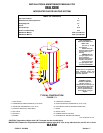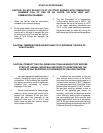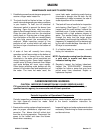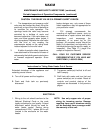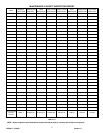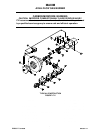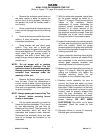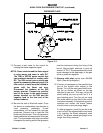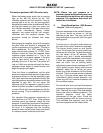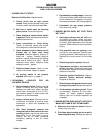PV500-17 05-2000 Section 17
7
MAXIM
AXIAL FLOW GAS BURNER START-UP
(Refer to Figure 17-2, page 6 to identify burner parts)
1. Remove the enclosure panel cover on
the water heater or boiler to expose the
control circuit. A wiring diagram, included in
this packet, will show the controls used in
our circuitry.
2. Visually check that all components are
intact and no damage has occurred during
transit.
3. Check all connections within the control
cabinet. A loose connection could cause
intermittent shutdowns.
4. Some burners will use direct spark
ignition. They may use a single gas
pressure regulator and gas valve or multiple
valves and regulators. On a call for heat, the
motor starts, the gas primary control is
energized, and after a short delay (pre-
purge) the gas valve(s) opens and ignition
should occur.
NOTE: Do not tamper with or readjust
program dipswitch settings. This will
cause the control to become inoperable.
Damage resulting from tampering will be
excluded from coverage under the
warranty of this unit.
5. Remove the flame safeguard control
from its base. Check the connections in
control mounting base; loose connections
can cause nuisance shutdowns. Check the
time card or programmer, when applicable,
for good connection.
NOTE: Always secure gas lines and tag "Out
of Service" before servicing burner
nozzle or electrodes.
6. Pull the nozzle assembly to check the
flame and ignition electrodes. This is done
by first disconnecting the gas train by
breaking at the unions. Then removing the
nozzle assembly which will have the
electrodes and pressure plate attached.
Disconnect the electrode wires and take
care not to damage the insulation on the
electrodes.
7. With the electrodes exposed, check them
for the proper settings as called for in
Figure 17-3, page 8. Check for any hairline
cracks in the insulators. Should
replacement of burner electrodes be
required, certain procedures must be
followed. In all cases, removal of the
electrodes is accomplished by loosening
the electrode mounting clamps. Draw the
electrodes out of the nozzle assembly
through the holes in the pressure plate.
8. Inspect the electrodes for cracked ceramic
or loose retaining studs that hold the wire
within the ceramic. Select the proper
pressure plate hole to place each electrode
and insert the electrode through the hole,
retaining stud end first.
9. Tighten electrode mounting clamp slightly
until electrode ceramics are seated firmly
and completely in the mounting bracket
without gaps between ceramics and
mounting bracket at the bearing faces.
10. Measure and set electrodes according to
Figure 17-3, page 8. After the gaps and
setting are complete, fully tighten the
electrode mounting clamp. Do not
overtighten or the insulation may crack.
11. Replace nozzle assembly; be sure to
connect the flame and spark rod wires
before installing nozzle assembly fully into
blast tube. Check connectors on the ends
of the flame and spark rod wires for good
contact. Look for properly stripped wire
ends. Be sure connectors are firmly
attached to the flame and ignition rod ends.
Insulating boots can give a false feeling of
proper seating. DO NOT MOVE
ELECTRODES. Be careful not to bump
electrodes. Check fan wheel for free
rotation.
12. Reinstall orifices in unions (if required).
Reinstall gas nozzle assembly.



